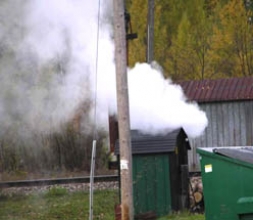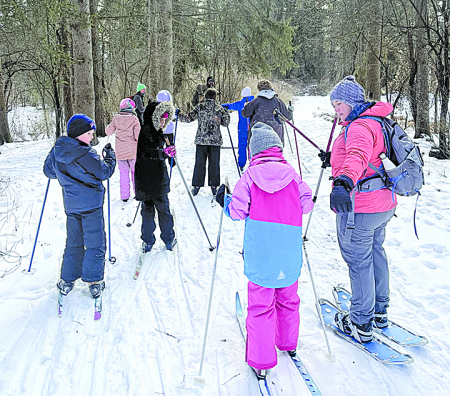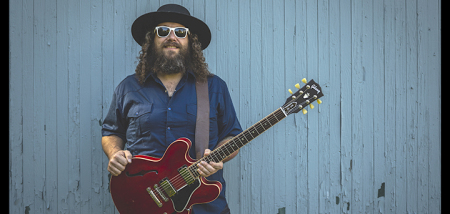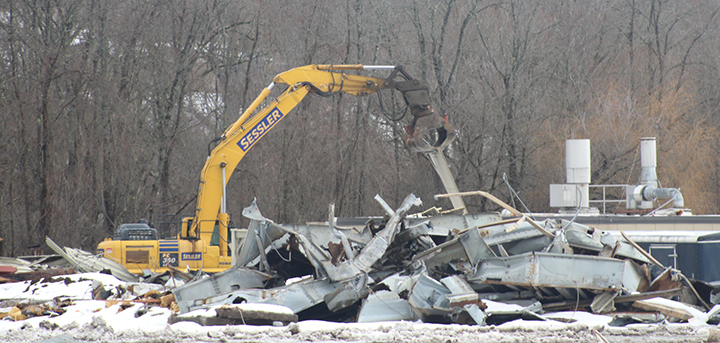Outdoor Wood Boilers: Economical Alternative Or Neighborhood Scourge?
Published:
January 18th, 2007
By:
Michael McGuire

CHENANGO COUNTY – Rising fuel prices have caused people to question the necessity of America’s dependence on foreign oil, considering the technology and resources that many contend are available domestically to meet the country’s needs. But the search for alternative energy sources is not without debate, and residents of Chenango County are deciding if they want these new options to be cleaner or cheaper, if not both.
Locally, outdoor wood-burning boilers have drawn praise and criticism as both an economically sound use of an abundant resource, and a harmful pollutant that dirties the surrounding air – and the lungs that breathe it. In response, some municipalities in the state, including the Village of Oxford, have banned the heating systems from use in their jurisdictions.
Town of Bainbridge resident Dianne Kemmeren, a dairy farmer, said that she heats her home and the milk house across the road using two separate outdoor boilers, noticing no evident ill effects in the two years she’s used them.
“It will smoke for two to three minutes; other than that it burns clean,” she said.
Currently, there are no official state or federal regulations or emissions standards protecting consumers against the amount of particulate matter – particles that exist or are given off in certain instances that can be harmful to the heart and lungs – the wood produces when burned in these devices.
With an abundance of wood already on site – plus the prospect of avoiding a mess indoors, having wood-heated domestic water, and an evenly heated house compared to homes with indoor wood stoves – Kemmeren said the wood boiler seemed like, and has been, a logical option.
“I’ve been keeping it at 70 to 72 (degrees). If I’m cold, I’m not afraid to turn it up,” she said, explaining that before she was worried how comfort would translate onto her heating bill. “That’s not an issue with me anymore. There was nothing like coming into a cold house after you’ve been outside all day.”
In August 2005, then-New York state Attorney General Eliot Spitzer released a report stating that, amongst other scientific claims, that “under certain conditions outdoor wood boilers may be among the dirtiest and least economical methods of heating.”
“My office regularly receives calls from people living near outdoor wood boilers, complaining of severe air pollution and health problems,” said Attorney General Spitzer. “After examining the complaints, we found that there are no standards for these devices. The last thing we need is more local air pollution. Just as wood stoves must meet air pollution emission standards, so should these outdoor wood boilers.”
Kemmeren claims misuse and abuse have brought down the negative charges on the now controversial heating system.
“The biggest problem is that people are burning things other than wood,” she said. “It’s the abuse that has made outdoor boilers a nasty thing. I don’t care who you are, if you burn garbage, that’s offensive to everybody. I wouldn’t want to be their neighbor either.”
County Code Enforcement Officer Bruce Bates said he does receive complaints from neighbors and others regarding the smoke the outdoor wood burners produce.
“I call them yard dragons,” said Bates, referring to the units. “They make a lot of smoke. When it’s not calling for heat it’s smoldering – that creates a problem.”
Bates said there are a mix of complaints related to bad burning practices and the normal emissions the boilers create. However, he explained that heating structures that are constructed to code aren’t subject to any other regulations, and that air quality issues are turned over to the Department of Environmental Conservation.
“They are not bad in rural areas,” Bates said. “When you have it in close proximity with other structures, then it becomes a problem.”
A host of states in the Northeast, led by New York, called on the U.S. Environmental Protection Agency to create federal regulations for manufacturers and homeowners to follow, as was done in 1998 for indoor stoves. Right now the EPA is working on creating industry standards that manufacturers are expected to voluntarily implement, as opposed to developing regulations that could take much more time, officials said.
“We think we can get units that burn 70 percent cleaner just through improving combustion efficiency,” said John Millet, a spokesman for the EPA. “The hotter they burn, the cleaner the emissions.”
Millet said that he wouldn’t characterize the boilers themselves as dangerous, but rather what they burn aside from wood, and how they burn it, is what creates the problem.
So far, Kemmeren’s neighbor Fred Lee, who lives approximately a half mile down the road from the boilers, said he’s hasn’t noticed much of anything coming from the smoke stacks when he’s driven or walked by.
“There is really hardly any smoke coming out of that thing,” said Lee. “You have to be relatively close to it to see smoke at all. For the country, it’s a rather nice piece of equipment. If I lived in the village I’d have a different opinion.”
Kemmeren agrees, saying that distance, among other things, is a necessary consideration people have to make.
Central Boiler, one of the largest manufactures of the outdoor system, said the recent studies that have vilified alternative heat source as cancer agents and polluters are unfounded.
“When installed and operated properly, Central Boiler outdoor furnaces provide a safe, cost-effective and environmentally responsible alternative for home heating,” a press release states. “Central Boiler is working closely with the EPA on testing standards and with state and local governments on appropriate regulations to prevent and correct misuse of outdoor wood furnaces – including the burning of anything other than wood and operating with too short of a chimney.” The company says the boilers should be at least 100 feet from other homes, and if within 300 feet, the chimney should be 2 feet higher than the residence.
When it comes to regulating what people put into their outdoor furnaces, “that’s going to be hard to regulate,” Kemmeren said. “People always want to cheat the program, and do it ‘my own way,’ and spoil it for everyone else.”
According to the state Attorney General’s Office, 7,500 of the outdoor wood burning boilers have been sold in New York since 1999, at average price of $5,500.
The report also claims that under certain conditions, outdoor boilers may release as much as 12 times the fine particle pollution released by EPA-certified wood stoves, 1,000 times more than oil furnaces and 1,800 times more than gas furnaces. The office added that the pollutants emitted by outdoor boilers can cause or contribute to health problems such as asthma, heart and lung disease, cancer, eye, nose, throat and lung irritation, coughing and shortness of breath.
Author: Michael McGuire - More From This Author
Comments




